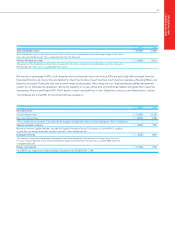Tesco 2007 Annual Report Download - page 21
Download and view the complete annual report
Please find page 21 of the 2007 Tesco annual report below. You can navigate through the pages in the report by either clicking on the pages listed below, or by using the keyword search tool below to find specific information within the annual report.
19
OPERATING AND
FINANCIAL REVIEW
Interest rate risk management The objective is to limit
our exposure to increases in interest rates while retaining the
opportunity to benefit from interest rate reductions. Forward
rate agreements, interest rate swaps, caps and collars are
used to achieve the desired mix of fixed and floating rate debt.
The policy is to fix or cap a minimum of 40% of actual and
projected debt interest costs. At the year end, £2.3bn of debt
was in fixed rate form (last year £1.5bn) with a further £1.0bn
of debt capped or collared, therefore 86% (2006 – 53%)
of net debt is fixed, capped or collared. Fixed rate debt
includes £693m of funding linked to the Retail Price Index
(2006 – £472m).
This debt reduces interest risk by diversifying our funding
portfolio. The remaining balance of our debt is in floating
rate form.
The average rate of interest paid on a historic cost basis
excluding joint ventures and associates this year was 4.8%
(last year 5.2%).
Foreign currency risk management Our principal objective
is to reduce the effect of exchange rate volatility on short-term
profits. Transactional currency exposures that could significantly
impact the Income Statement are hedged, typically using
forward purchases or sales of foreign currencies and currency
options. At the year end, forward foreign currency transactions,
designated as cash flow hedges, equivalent to £764m were
outstanding (2006 – £548m) as detailed in note 20.
We hedge the majority of our investments in our international
subsidiaries via foreign exchange transactions in matching
currencies. Our objective is to maintain a low cost of borrowing
and hedge against material movements in our Balance Sheet
value. During the year, currency movements decreased the
net value of the Group’s overseas assets by £77m (last year
increase of £27m). We translate overseas profits at average
exchange rates which we do not currently seek to hedge.
Credit risk The objective is to reduce the risk of loss arising
from default by parties to financial transactions across an
approved list of counterparties of high credit quality. The
Group’s positions with these counterparties and their credit
ratings are routinely monitored.
Tesco Personal Finance (TPF) TPF lending is predominantly
to individuals through its credit card and unsecured personal
loan products. TPF has also developed a significant insurance
business, with motor insurance a major component. TPF risk
is managed by observing and adopting industry best practices
and drawing upon the expertise and systems of the Royal
Bank of Scotland Group, including its subsidiary Direct Line.
All policies pertaining to risk within TPF are subject to the
governance procedures of the Royal Bank of Scotland Group
and ratified by the TPF Board, which has representation from
both Tesco and the Royal Bank of Scotland Group. This has
delivered a portfolio of products with strong asset quality. This
asset quality is maintained through proactive risk management,
both at the time of acquisition and ongoing account
maintenance.
The Tesco Group would support its 50% share of any further
funding TPF might require to sustain liquidity ratios. However,
we believe that provisions for bad debts and insurance losses
(supported by re-insurance of significant risks) are at
prudent levels.
Insurance We purchased Assets, Earnings and Combined
Liability protection from the open insurance market at
‘catastrophe’ level only. The risk not transferred to the insurance
market is retained within the business by using our captive
insurance companies, Tesco Insurance Limited in Guernsey and
Valiant Insurance Company Limited in the Republic of Ireland.
Tesco Insurance Limited covers Assets and Earnings, while
Valiant Insurance Company Limited covers Combined Liability.
Statement of compliance
This review has been prepared in accordance with the
Directors’ Report Business Review Requirements in section
234ZZB of the Companies Act 1985. It also incorporates much
of the guidance set out in the Accounting Standards Board’s
Reporting Statement on the Operating and Financial Review.
The OFR’s intent is to provide information to shareholders
and should not be relied on by any other party or for any
other purpose.
Where this review contains forward-looking statements,
these are made by the Directors in good faith based on the
information available to them at the time of their approval of
this report. These statements should be treated with caution
due to the inherent uncertainties underlying any such forward-
looking information.
Other information
Additional financial and non-financial information, including
press releases and year end presentations, can be accessed
on our website, www.tesco.com/corporate and also in our
Corporate Responsibility Review 2007.
























